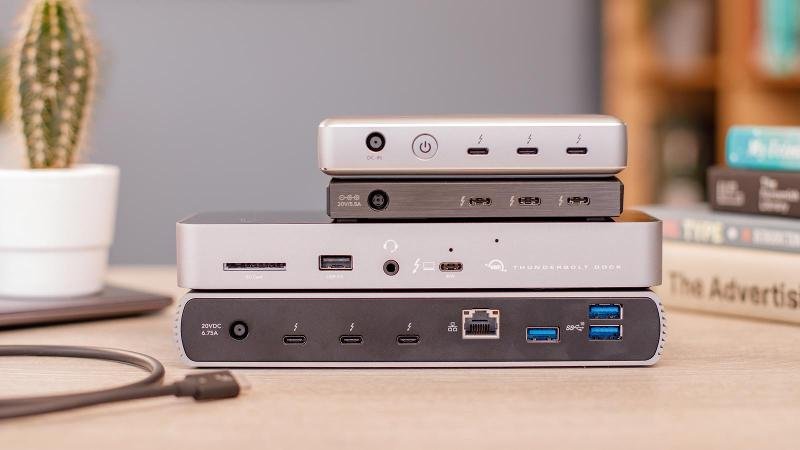Thunderbolt 4 and USB4 hubs and docks are the latest technologies in computer connectivity and expansion. They take over from Thunderbolt 3 and USB-C hubs and docks, with significant future-proof benefits while staying backwards compatible with the older connectivity standards.
Hubs and docks allow you to add more types of connections to your main computer if it lacks them itself – particularly with laptops that might have just a few ports on the side.
Desktop PCs and Macs usually have a decent set of ports at front and back, but laptops and tablets often have just a couple.
You will therefore need to connect a multifunction adapter, hub or a more able docking station that includes the ports and slots you need to add extra devices such as hard drives, memory sticks, storage-card readers, printers and so on, as well as wired input tools such as a keyboard or mouse.
They are also the best way to add an external display or two to your more mobile computer, plus Gigabit (or faster) Ethernet for wired Internet access.
Thunderbolt 4 and USB4
The latest connection standards are Thunderbolt 4 and USB4, which are both based on the neat reversible USB-C connector seen on most new computing devices.
Learn more about the differences between USB-C, USB4, Thunderbolt 3 and Thunderbolt 4.
They supersede older USB 3.0/USB-A connectors and also slower USB-C variants in terms of speed, but are backwards compatible with USB-C and Thunderbolt 3.
USB-A (the old rectangular connector that had to go in one way, usually not the first way you tried) usually maxed at a bandwidth of 5Gbps (USB 3.0) but could be as slow as 480MBps (USB 2.0).
USB-C started at 5Gbps but is also available at up to 20Gbps, although 10Gbps is more common at the upper end.
Thunderbolt 3 (TB3) can reach 40Gbps, but, unlike Apple, some Windows PC manufacturers didn’t choose to offer all TB3’s benefits.
Thunderbolt 4 (TB4) and USB4 require manufacturers to comply with all the technology’s benefits (such as 40Gbps bandwidth) to be certified, which makes TB4 much more trustworthy to PC users than TB3.
Apple users won’t see much difference between TB3 and TB4, but there are extra benefits such as the ability to better daisy chain devices. With TB3 a device chain could be disrupted with the removal of any but the final device in the chain.
Many hub and dock manufacturers advise Windows users that their device needs to be certified for Thunderbolt 4 or USB4 due to previous connectivity-standard inconsistency. Mac users will be fine with older USB-C (12in MacBook) and Thunderbolt 3 systems.
You can still use Thunderbolt 3 and USB-C docking stations, but you’ll miss out on Thunderbolt 4’s advancements.
TB4/USB4 also offers faster PCIe (peripheral component interconnect express) at 32Gbps for storage speeds up to 3,000MBps – double the minimum requirements of Thunderbolt 3, although more recent MacBooks have this already. Some of the early TB3 MacBooks had less bandwidth available on the right-hand-side Thunderbolt ports.
After our roundup of the best Thunderbolt 4 hubs and docks, we go into more detail about each type of port or connection that you need.
Best Thunderbolt 4 Hub: Caldigit Thunderbolt 4 Element Hub
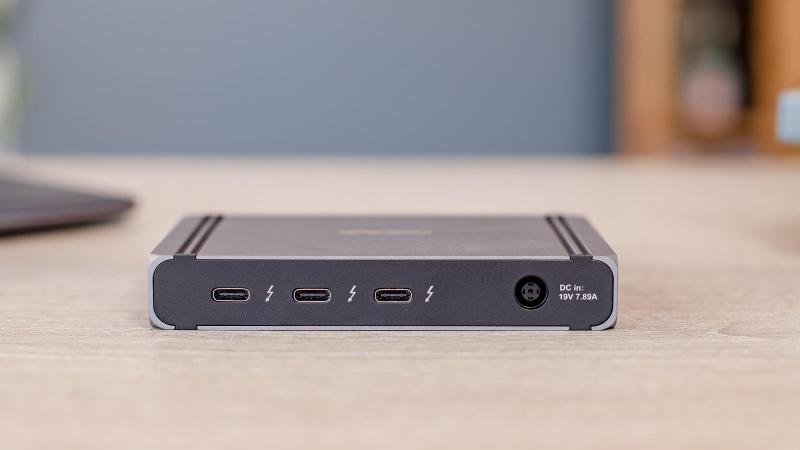
- Pros
- Four Thunderbolt 4 ports
- Four fast USB-A ports
- 150W power supply
- Cons
- 60W laptop charging could be light for larger laptops
• One upstream Thunderbolt 4 port (40Gbps, 60W)
• Three downstream Thunderbolt 4 ports (40Gbps, 15W)
• Four USB-A ports (10Gbps, 7.5W)
• 150W power supply
You won’t find any more modern USB ports on a hub or docking station than you get with Caldigit’s compact and well-priced Thunderbolt 4 / USB4 Element Hub, and they are all rated at top speeds.
It boasts four Thunderbolt 4 (all at 40Gbps bandwidth and 15W charging) and four USB-A 3.2 Gen.2 (10Gbps and 7.5W) ports. That’s more than any other Thunderbolt 4 hub we have seen or tested.
One of the TB4 ports is Upstream, for connection to your computer. The other three are Downstream, for connecting other devices.
Caldigit’s Thunderbolt 4 Element Hub is not a docking station by strict definition but it has so many USB ports (both Type A and Type C) that it can certainly be used as a dock if you have the right external device ports or adapters for adding external displays.
If used as a dock, the Element Hub is one of the smallest you’ll find with its own power supply
At 150W, the power supply should accommodate most of your needs, with up to 60W reserved for powering the laptop or tablet – enough for all but the biggest, meanest laptops.
Read our full Caldigit Thunderbolt 4 Element Hub review
Best Budget Thunderbolt 4 Hub: OWC Thunderbolt Hub
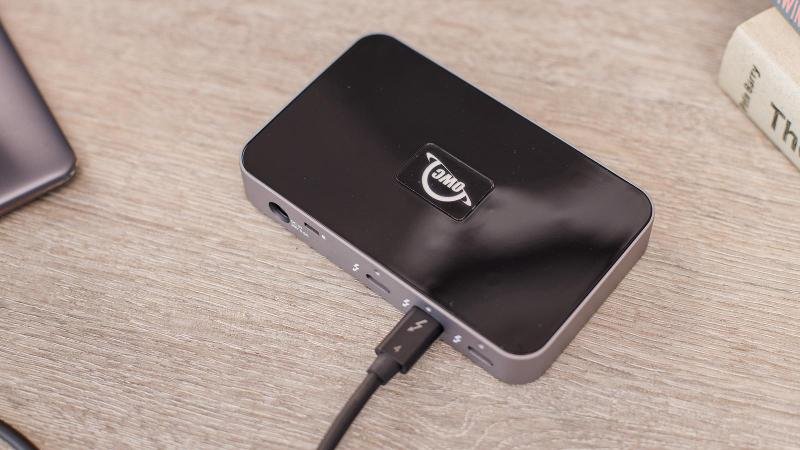
- Pros
- Four Thunderbolt 4 ports
- One fast USB-A port
- Cons
- 60W laptop charging could be light for larger laptops
• One upstream Thunderbolt 4 port (40Gbps, 60W)
• Three Thunderbolt 4 ports (40Gbps, 15W)
• One USB-A port (10Gbps, 7.5W)
• 110W power supply
The OWC Thunderbolt Hub delivers with an upstream Thunderbolt 4 port, three downstream Thunderbolt 4 ports, and an extra USB-A port thrown in for good measure.
The price is the lowest we’ve seen for one of these latest Thunderbolt 4 or USB4 hubs.
All four Thunderbolt 4 are rated at 40Gbps bandwidth and 15W charging, and one USB-A 3.2 Gen.2 (10Gbps and 7.5W) port. The TB4 ports can be used for adding SSDs and other USB-C, TB3 or TB4 devices or external displays, depending on your needs.
It has a 110W power supply, which is all you should need for the number of ports on offer, and it can charge a laptop at up to 60W.
Read our full OWC Thunderbolt Hub review
Best full Thunderbolt 4 dock: Kensington SD5700T Thunderbolt 4 Docking Station

- Pros
- 11 fast ports
- 170W power supply
- Quality build
- Cons
- Upstream port at front
- 4.5W USB-A ports
• One upstream Thunderbolt 4 port (40Gbps, 90W)
• Three Thunderbolt 4 ports (40Gbps, 15W)
• Three USB-A ports (10Gbps, 4.5W)
• One USB-A port (480MBps, 7.5W)
• Gigabit Ethernet
• UHS-II SD Card reader (320MBps)
• 3.5mm audio jack
• 170W power supply
As you’d expect from Kensington, the SD5700T Thunderbolt 4 Docking Station is a quality build with everything a dock should have: four TB4 ports, three fast USB-A and one slow one (that at least boasts 7.5W charging power compared to the faster USB-A 3.2 Gen 2 ports’ 4.5W), Gigabit Ethernet, SD Card reader, and audio jack.
At 170W, the power supply is the best we’ve seen in all our hub and dock tests.
There are useful lights telling you when the dock is powered and when it’s connected, and we like the On/Off button, too.
Read our full Kensington SD5700T Thunderbolt 4 Docking Station review
Best Thunderbolt 4 dock for HDMI displays: Anker Apex Thunderbolt 4 Docking Station
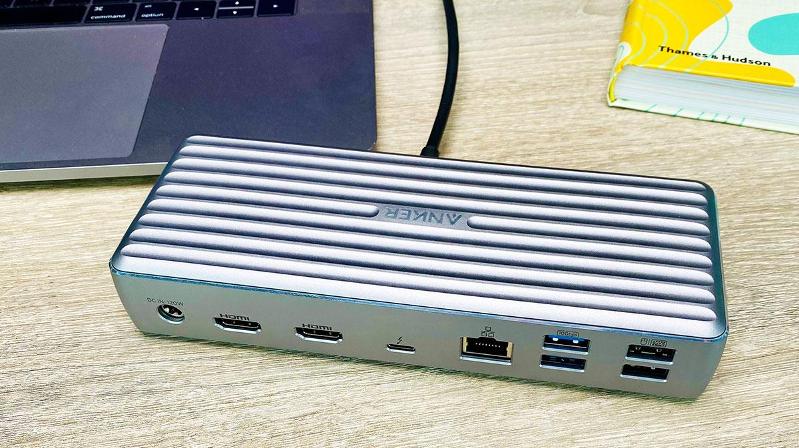
- Pros
- 12 ports inc. four TB4, two HDMI ports and Gigabit Ethernet
- Power button
- Cons
- Only one downstream TB4 port
• One upstream Thunderbolt 4 port (40Gbps, 90W)
• One downstream Thunderbolt 4 port (40Gbps, 15W)
• One USB-C port (10Gbps, 20W)
• Two USB-A ports (10Gbps, 7.5W)
• Two USB-A ports (480MBps, 2.5W)
• Two HDMI 2.0 ports (4K at 60Hz)
• Gigabit Ethernet
• UHS-II SD Card reader (320MBps)
• 3.5mm audio jack
• 120W power supply
The Anker Apex Thunderbolt 4 Docking Station is a great choice if you need to connect more than one external display to your laptop.
Other Thunderbolt 4 docks we’ve tested rely solely on the TB4 ports for display connections. This means that if you want two external screens, you lose two of the three downstream TB4 ports, plus you will need HDMI or DisplayPort adapters unless the displays have a USB-C connection.
Anker’s inclusion of two HDMI ports means you don’t need any adapters to connect displays. There’s just one downstream TB4 port, but that’s all you’d have left if you connected two displays to one of the other docks or hubs.
If you aren’t planning on adding two screens, this dock is less flexible than other hubs and docks where the TB4 ports can be used for display or whatever else you desire.
The sole downstream TB4 port can also be used to connect an external monitor, so it’s possible for owners of Thunderbolt 4 Windows laptops to have as many as three displays running out of the dock: two HDMI and one TB4. Mac owners will need to add third-party DisplayLink software to achieve three displays.
An extra mark for adding a power button on the front so that your laptop isn’t receiving a potential charge when it’s not needed, and keeping the dock’s temperature down at night.
Read our full Anker Apex 12-in-1 Thunderbolt 4 Dock review
Sonnettech Echo 11 Thunderbolt 4 Dock
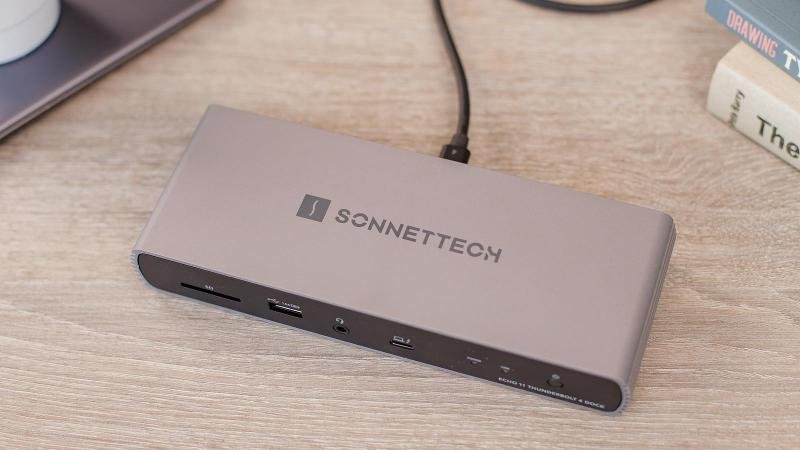
- Pros
- 11 ports inc. four Thunderbolt 4 and Gigabit Ethernet
- 90W laptop charging
- Cons
• One upstream Thunderbolt 4 port (40Gbps, 90W)
• Three Thunderbolt 4 ports (40Gbps, 15W)
• Three USB-A ports (10Gbps, 7.5W)
• One USB-A port (480MBps, 7.5W)
• Gigabit Ethernet
• UHS-II SD Card reader (320MBps)
• 3.5mm audio jack
• 135W power supply
The Sonnettech Echo 11 Thunderbolt 4 Dock boasts a full range of ports, including of course the all-important four T4 connections.
You’ll find the same number of Thunderbolt 4 ports on the much-cheaper hubs, but you won’t find this dock’s Gigabit Ethernet, SD Card slot and headphone jack. You can add adapters to the hubs to include these but that, of course, adds to the overall cost.
Another advantage for owners of larger laptops is the dock’s ability to charge at 90W rather than the hub’s maximum 60W.
Read our full Sonnettech Echo 11 Thunderbolt 3 Dock review
Best Thunderbolt 4 Hub for laptop charging: Anker PowerExpand 5-in-1 Thunderbolt 4 Mini Dock
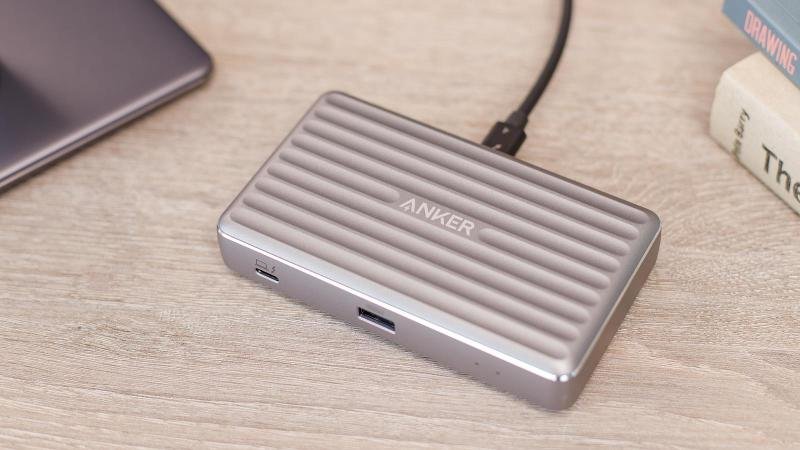
- Pros
- Four Thunderbolt 4 ports
- 85W laptop charging
- Power button
- Cons
- Low overall 100W power supply
• One upstream Thunderbolt 4 port (40Gbps, 85W)
• Three downstream Thunderbolt 4 ports (40Gbps, 15W)
• One USB-A port (10Gbps)
• 100W power supply
The Anker PowerExpand 5-in-1 Thunderbolt 4 Mini Dock is similar to the other Thunderbolt 4 hubs but calls itself a “mini dock”, which is fine as all the hubs can act as docks if you have the right adapters for Ethernet and external displays.
It beats other similar Thunderbolt 4 hubs with its 85W laptop-charging power (compared to 60W elsewhere). That said, its total 100W external power supply feels a little light given the potential 67.5W power drain if all the ports required charging simultaneously.
Read our full Anker PowerExpand 5-in-1 Thunderbolt 4 Mini Dock review
Plugable Thunderbolt 4 and USB4 Hub
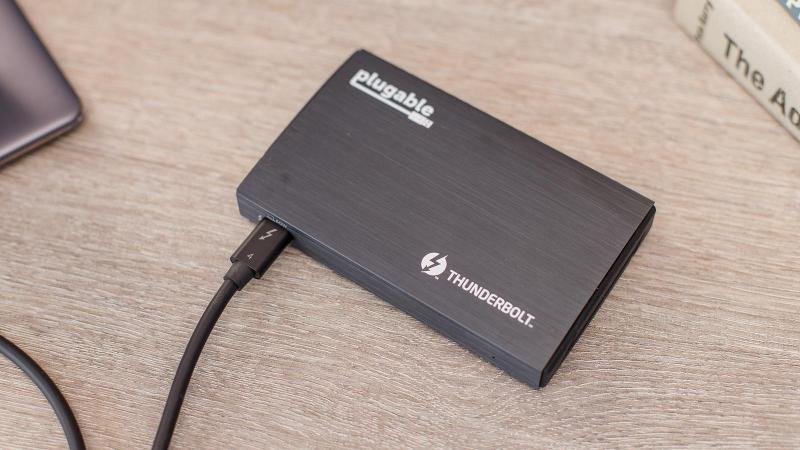
- Pros
- Four Thunderbolt 4 ports
- USB-C-to-HDMI adapter
- Cons
• One upstream Thunderbolt 4 port (40Gbps, 60W)
• Three Thunderbolt 4 ports (40Gbps, 15W)
• 110W power supply
Plugable’s Thunderbolt 4 Hub includes the maximum Thunderbolt 4 ports (one upstream to the computer, and three downstream for other devices) but nothing else.
Handily there’s a USB-C-to-HDMI-2.0 adapter that you can use to attach an external display. Other hubs require you to buy such an adapter.
Read our full Plugable Thunderbolt 4 Hub review
What is the difference between adapters, hubs and docks?
These terms are used quite fluidly, but there are official definitions.
A hub usually combines multiples of the same type of port – for example, old-school USB-A connections – but often collects a few different ports in a compact form, frequently with a power supply.
A multi-format adapter adds different kinds of ports, usually in a very portable format that can either draw power from the host computer or channel pass-through power delivery via a USB-C port and your USB-C charger.
A docking station (or dock) is a larger beast with its own bulky power supply and a range of different ports that should cover all your connection and charging needs.
The definitions have merged somewhat and are now often more about the size and format rather than the capabilities.
Which ports do you need?
To connect the hub or dock, your computer will need to include either a Thunderbolt 4 port for a separate cable connection (often included with the hub/dock) or an integrated T4/USB4 cable.
Thunderbolt 4 / USB4 ports The TB4/USB4 technology allows for four of these ports on a hub or dock – one of which is reserved for the computer connection (called the ‘Upstream” connection, compared to the “Downstream TB4 ports that you use to connect new devices). Previously, TB3 allowed for only two in total.
These are very adaptable ports that can connect to a USB-C display or a display adapter – for example, USB-C-to-HDMI or DisplayPort.
…
